A Dual-Laser Sensor Based on Off-Axis Integrated Cavity Output Spectroscopy and Time-Division Multiplexing Method
Abstract
1. Introduction
2. Experimental Design and Methods
2.1. The Dual-Laser OA-ICOS Sensor Setup
2.2. Selection of CO2 and CH4 Absorption Lines
2.3. Time-Division Multiplexing Method in the Dual-Laser OA-ICOS Sensor
2.4. Performance Optimization Using Exponential Moving Average
3. Results and Discussion
3.1. The Stability of Temperature and Pressure
3.2. Calibration
3.3. Long-Term Stability
3.4. Detection of Ambient Air with the Dual-Laser OA-ICOS Sensor
4. Conclusions
Author Contributions
Funding
Conflicts of Interest
References
- Sun, K.; Wang, S.K.; Sur, R.; Chao, X.; Jeffries, J.B.; Hanson, R.K. Time-resolved in situ detection of CO in a shock tube using cavity-enhanced absorption spectroscopy with a quantum-cascade laser near 4.6 mu m. Opt. Express 2014, 22, 24559–24565. [Google Scholar] [CrossRef] [PubMed]
- Nadeem, F.; Mandon, J.; Cristescu, S.M.; Harren, F.J.M. Intensity enhancement in off-axis integrated cavity output spectroscopy. Appl. Opt. 2018, 57, 8536. [Google Scholar] [CrossRef] [PubMed]
- Shen, G.; Chao, X.; Sun, K. Modeling the optical field in off-axis integrated-cavity-output spectroscopy using the decentered Gaussian beam model. Appl. Opt. 2018, 57, 2947. [Google Scholar] [CrossRef] [PubMed]
- Chao, X.; Shen, G.; Sun, K.; Wang, Z.; Meng, Q.; Wang, S.; Hanson, R.K. Cavity-enhanced absorption spectroscopy for shocktubes: Design and optimization. Proc. Combust. Inst. 2019, 37, 1345–1353. [Google Scholar] [CrossRef]
- Rao, G.N.; Karpf, A. Extremely sensitive detection of NO₂ employing off-axis integrated cavity output spectroscopy coupled with multiple-line integrated absorption spectroscopy. Appl. Opt. 2011, 50, 1915–1924. [Google Scholar] [CrossRef]
- Karpf, A.; Rao, G.N. Real-time trace gas sensor using a multimode diode laser and multiple-line integrated cavity enhanced absorption spectroscopy. Appl. Opt. 2015, 54, 6085–6092. [Google Scholar] [CrossRef]
- Centeno, R.; Mandon, J.; Cristescu, S.M.; Harren, F.J.M. Sensitivity enhancement in off-axis integrated cavity output spectroscopy. Opt. Express 2014, 22, 27985–27991. [Google Scholar] [CrossRef]
- Kasyutich, V.L.; Martin, P.A.; Holdsworth, R.J. An off-axis cavity-enhanced absorption spectrometer at 1605 nm for the (CO2)-C-12/(CO2)-C-13 measurement. Appl. Phys. B Lasers Opt. 2006, 85, 413–420. [Google Scholar] [CrossRef]
- Moyer, E.J.; Sayres, D.S.; Engel, G.S.; Clair, J.M.S.; Keutsch, F.N.; Allen, N.T.; Kroll, J.H.; Anderson, J.G. Design considerations in high-sensitivity off-axis integrated cavity output spectroscopy. Appl. Phys. B Lasers Opt. 2008, 92, 467–474. [Google Scholar] [CrossRef]
- Kireev, S.V.; Kondrashov, A.A.; Shnyrev, S.L. Improving the accuracy and sensitivity of(13)C online detection in expiratory air using the TDLAS method in the spectral range of 4860-4880 cm(−1). Laser Phys. Lett. 2018, 15, 5. [Google Scholar] [CrossRef]
- Alquaity, A.B.S.; Utsav, K.C.; Popov, A.; Farooq, A. Detection of shock-heated hydrogen peroxide—(H2O2) by off-axis cavity-enhanced absorption spectroscopy (OA-CEAS). Appl. Phys. B Lasers Opt. 2017, 123, 8. [Google Scholar] [CrossRef]
- Zheng, K.; Zheng, C.; Li, J.; Ma, N.; Liu, Z.; Zhang, Y.; Wang, Y.; Tittel, F.K. Near-infrared methane sensor system using off-axis integrated cavity output spectroscopy with novel dual-input dual-output coupling scheme for mode noise suppression. Sens. Actuators B Chem. 2020, 308, 127674. [Google Scholar] [CrossRef]
- Berman, E.S.F.; Fladeland, M.; Liem, J.; Kolyer, R.; Gupta, M. Greenhouse gas analyzer for measurements of carbon dioxide, methane, and water vapor aboard an unmanned aerial vehicle. Sens. Actuators B Chem. 2012, 169, 128–135. [Google Scholar] [CrossRef]
- Zheng, K.; Zheng, C.; Yao, D.; Hu, L.; Liu, Z.; Li, J.; Zhang, Y.; Wang, Y.; Tittel, F.K. A near-infrared C2H2/CH4 dual-gas sensor system combining off-axis integrated-cavity output spectroscopy and frequency-division-multiplexing-based wavelength modulation spectroscopy. Analyst 2019, 144, 2003–2010. [Google Scholar] [CrossRef]
- Yang, C.; Mei, L.; Deng, H.; Xu, Z.; Chen, B.; Kan, R. Wavelength modulation spectroscopy by employing the first harmonic phase angle method. Opt. Express 2019, 27, 12137–12146. [Google Scholar] [CrossRef]
- Goldenstein, C.S.; Spearrin, R.M.; Jeffries, J.B.; Hanson, R.K. Infrared laser-absorption sensing for combustion gases. Prog. Energy Combust. Sci. 2017, 60, 132–176. [Google Scholar] [CrossRef]
- Sun, K.; Chao, X.; Sur, R.; Goldenstein, C.S.; Jeffries, J.B.; Hanson, R.K. Analysis of calibration-free wavelength-scanned wavelength modulation spectroscopy for practical gas sensing using tunable diode lasers. Meas. Sci. Technol. 2013, 24, 125203. [Google Scholar] [CrossRef]
- Goldenstein, C.S.; Jeffries, J.B.; Hanson, R.K. Diode laser measurements of linestrength and temperature-dependent lineshape parameters of H2O-, CO2-, and N2-perturbed H2O transitions near 2474 and 2482 nm. J. Quant. Spectrosc. Radiat. Transf. 2013, 130, 100–111. [Google Scholar] [CrossRef]
- Buldyreva, J.; Margules, L.; Motiyenko, R.A.; Rohart, F. Speed dependence of CH3 Cl-35-O-2 line-broadening parameters probed on rotational transitions: Measurements and semi-classical calculations. J. Quant. Spectrosc. Radiat. Transf. 2013, 130, 304–314. [Google Scholar] [CrossRef]
- Pogány, A.; Klein, A.; Ebert, V. Measurement of water vapor line strengths in the 1.4–2.7 µm range by tunable diode laser absorption spectroscopy. J. Quant. Spectrosc. Radiat. Transf. 2015, 165, 108–122. [Google Scholar] [CrossRef]
- Cai, T.; Wang, G.; Cao, Z.; Zhang, W.; Gao, X. Sensor for headspace pressure and H2O concentration measurements in closed vials by tunable diode laser absorption spectroscopy. Opt. Lasers Eng. 2014, 58, 48–53. [Google Scholar] [CrossRef]
- Wang, J.; Tian, X.; Dong, Y.; Zhu, G.; Chen, J.; Tan, T.; Liu, K.; Chen, W.; Gao, X. Enhancing off-axis integrated cavity output spectroscopy (OA-ICOS) with radio frequency white noise for gas sensing. Opt. Express 2019, 27, 30517–30529. [Google Scholar] [CrossRef] [PubMed]
- Wang, J.; Tian, X.; Dong, Y.; Chen, J.; Tan, T.; Zhu, G.; Chen, W.; Gao, X. High-sensitivity off-axis integrated cavity output spectroscopy implementing wavelength modulation and white noise perturbation. Opt. Lett. 2019, 44, 3298–3301. [Google Scholar] [CrossRef] [PubMed]
- Engel, G.S.; Moyer, E.J.; Keutsch, F.N.; Anderson, J.G. Innovations in Cavity Enhanced Laser Absorption Spectroscopy: Using in situ Measurements to Probe the Mechanisms Driving Climate Change. 2003. Available online: https://www.researchgate.net/profile/E_Moyer/publication/237635995_Innovations_in_Cavity_Enhanced_Laser_Absorption_Spectroscopy_Using_in_situ_Measurements_to_Probe_the_Mechanisms_Driving_Climate_Change/links/5417c5cb0cf2f48c74a4112a.pdf (accessed on 15 September 2020).
- Kireev, S.V.; Kondrashov, A.A.; Shnyrev, S.L.; Frolov, N.V. Kalman’s method to improve accuracy of online (CO2)-C-13-O-16 measurement in the exhaled human breath using tunable diode laser absorption spectroscopy. Laser Phys. Lett. 2018, 15, 4. [Google Scholar] [CrossRef]
- Wu, T.; Chen, W.; Fertein, E.; Masselin, P.; Gao, X.; Zhang, W.; Wang, Y.; Koeth, J.; Brueckner, D.; He, X. Measurement of the D/H, O-18/O-16, and O-17/O-16 Isotope Ratios in Water by Laser Absorption Spectroscopy at 2.73 mu m. Sensors 2014, 14, 9027–9045. [Google Scholar] [CrossRef]
- Schiller, C.L.; Bozem, H.; Gurk, C.; Parchatka, U.; Königstedt, R.; Harris, G.W.; Lelieveld, J.; Fischer, H. Applications of quantum cascade lasers for sensitive trace gas measurements of CO, CH4, N2O and HCHO. Appl. Phys. B 2008, 92, 419–430. [Google Scholar] [CrossRef]
- Xie, Q.; Li, J.; Gao, X.; Jia, J. Fourier domain local narrow-band signal extraction algorithm and its application to real-time infrared gas detection. Sens. Actuator B Chem. 2010, 146, 35–39. [Google Scholar] [CrossRef]
- Grebenkov, D.S.; Serror, J. Following a trend with an exponential moving average: Analytical results for a Gaussian model. Phys. A Stat. Mech. Appl. 2014, 394, 288–303. [Google Scholar] [CrossRef]
- Tsokos, C.P. K-th Moving, Weighted and Exponential Moving Average for Time Series Forecasting Models. Eur. J. Pure Appl. Math. 2010, 3, 406–416. [Google Scholar]
- Werle, P.; Mücke, R.; Slemr, F. The limits of signal averaging in atmospheric trace-gas monitoring by tunable diode-laser absorption spectroscopy (TDLAS). Appl. Phys. B 1993, 57, 131–139. [Google Scholar] [CrossRef]
- Baer, D.S.; Paul, J.B.; Gupta, J.B.; O’Keefe, A. Sensitive absorption measurements in the near-infrared region using off-axis integrated-cavity-output spectroscopy. Appl. Phys. B Lasers Opt. 2002, 75, 261–265. [Google Scholar] [CrossRef]
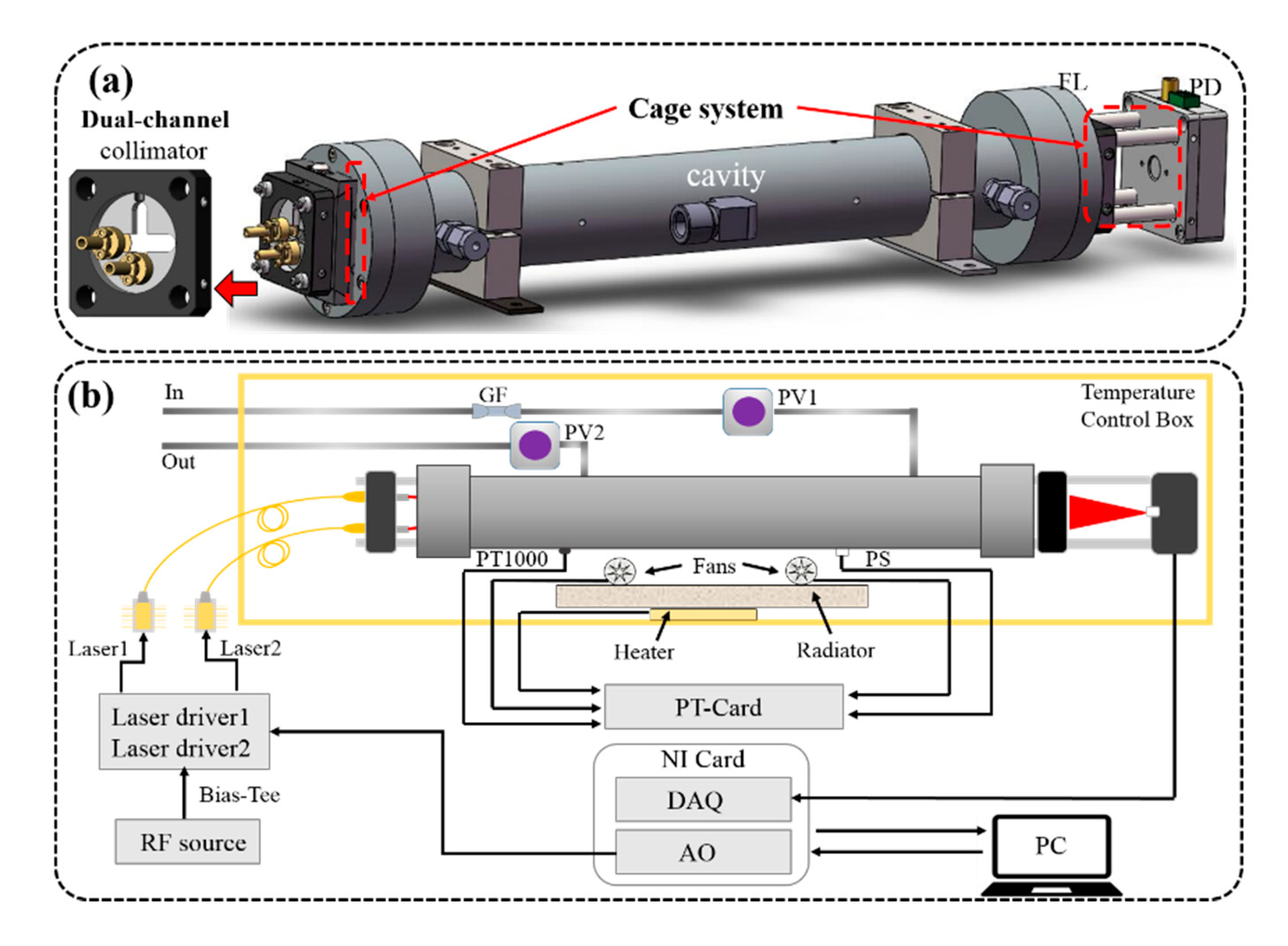


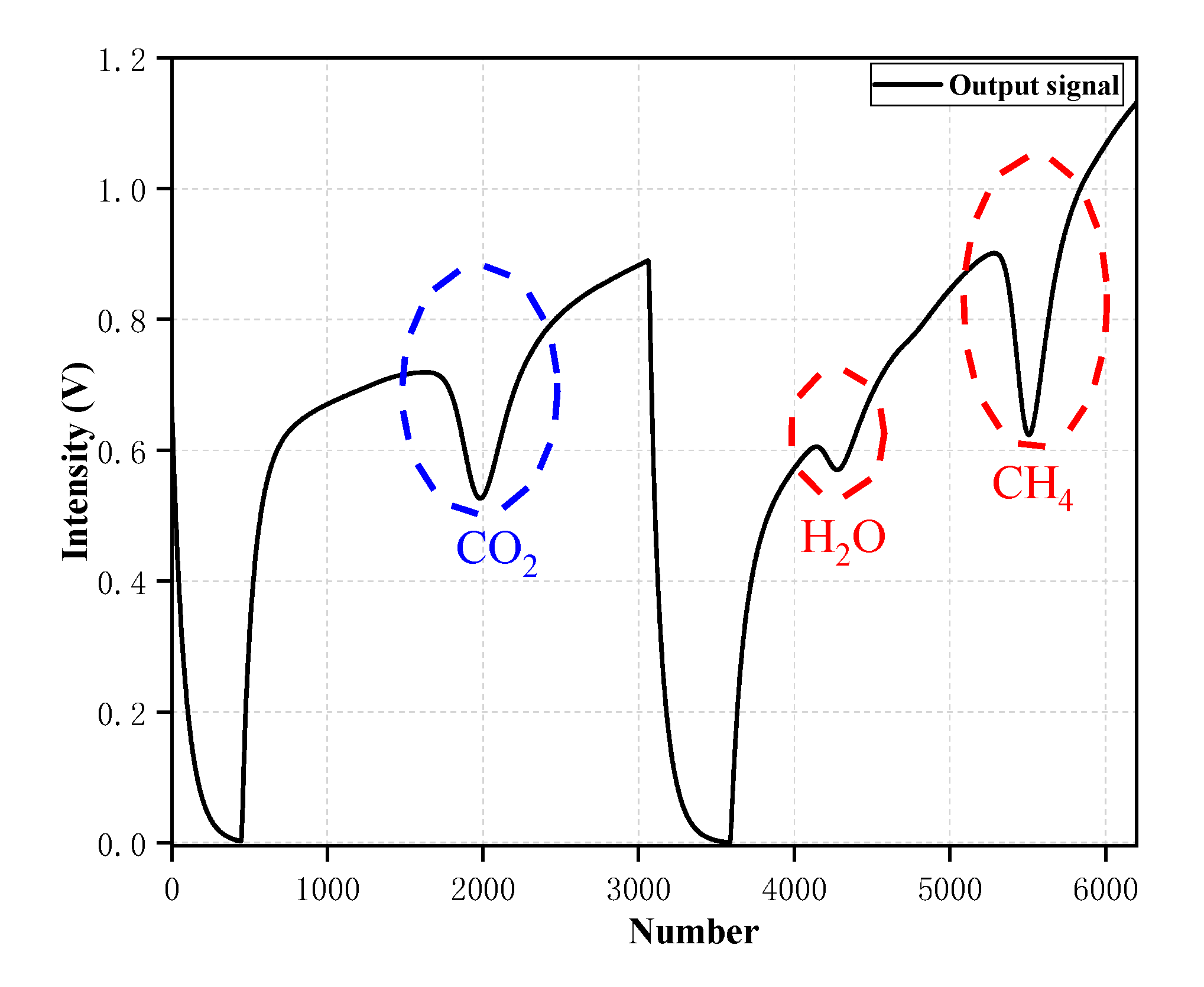

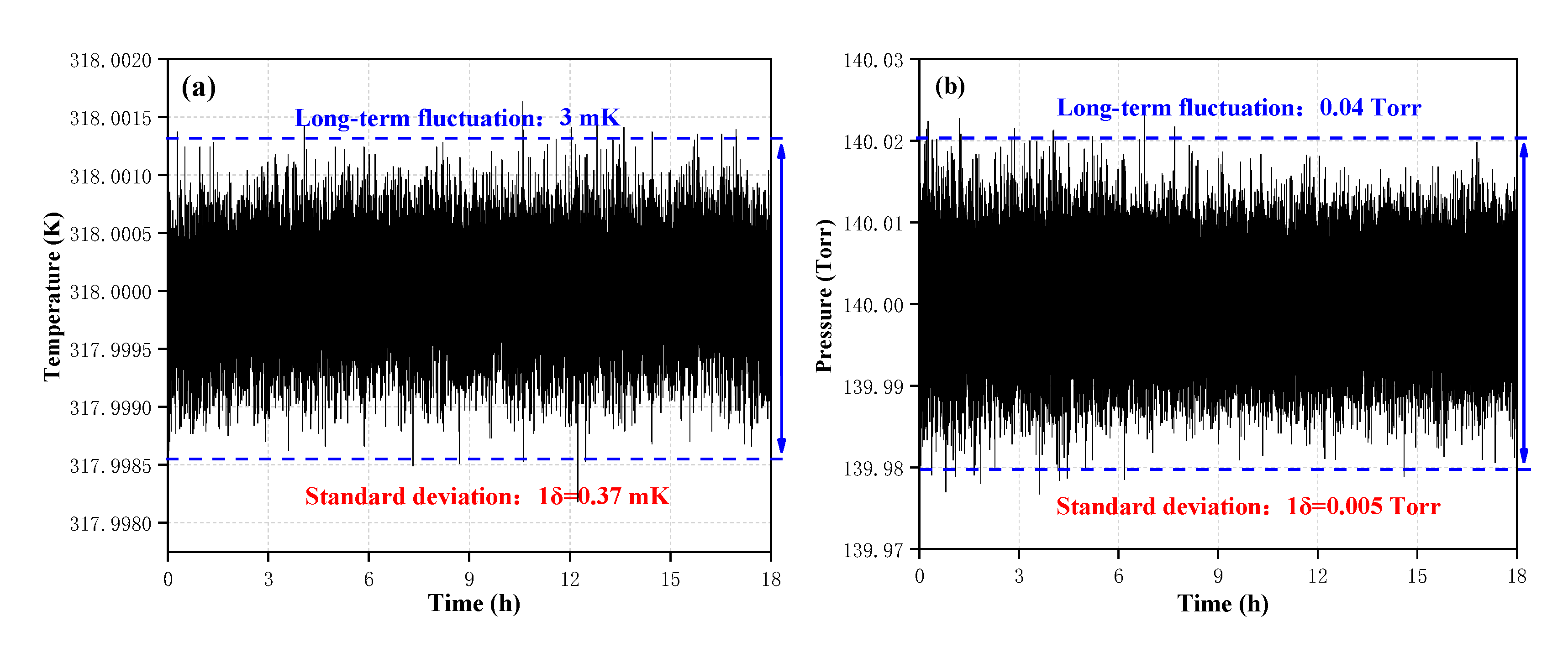
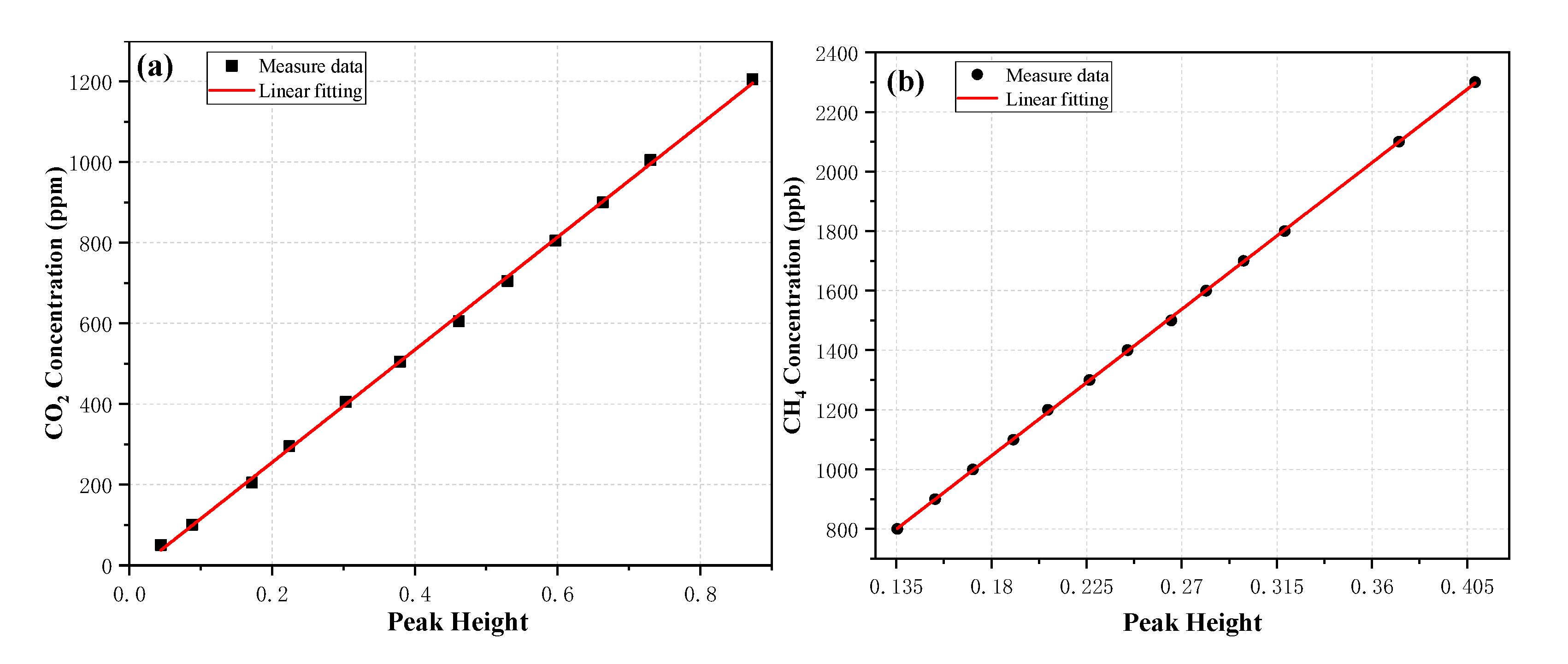
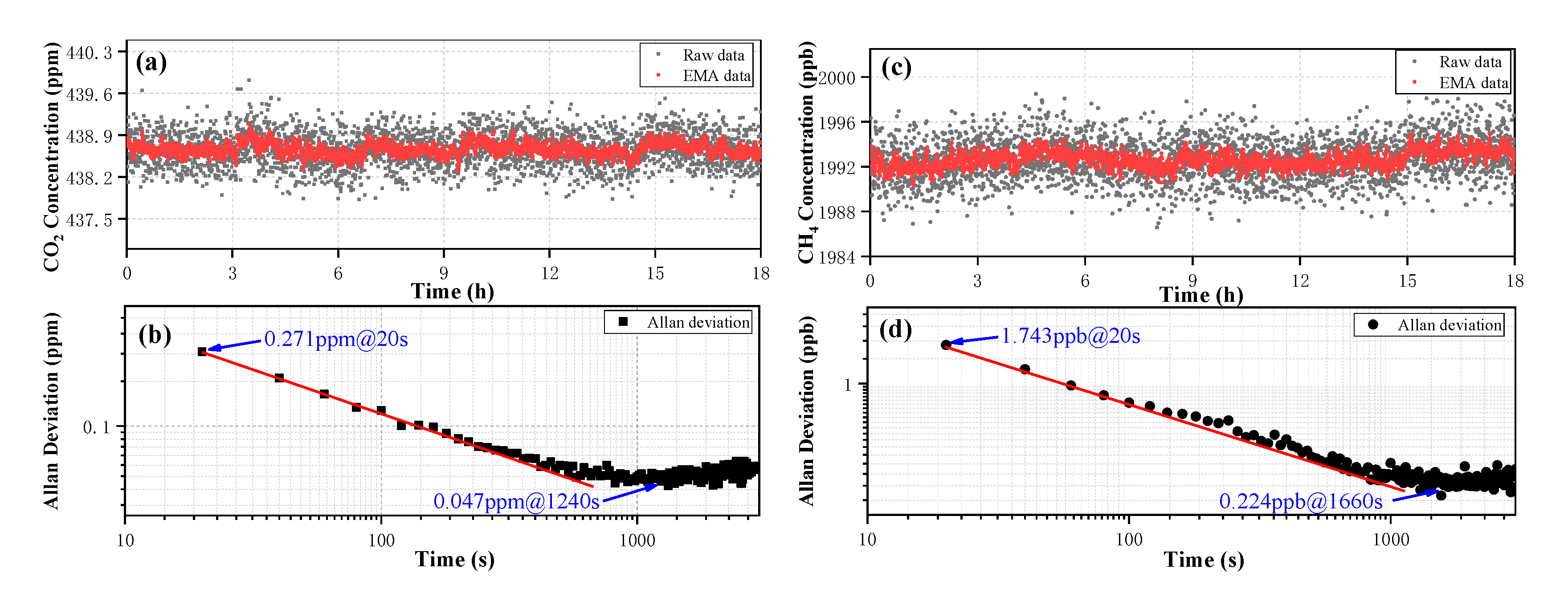
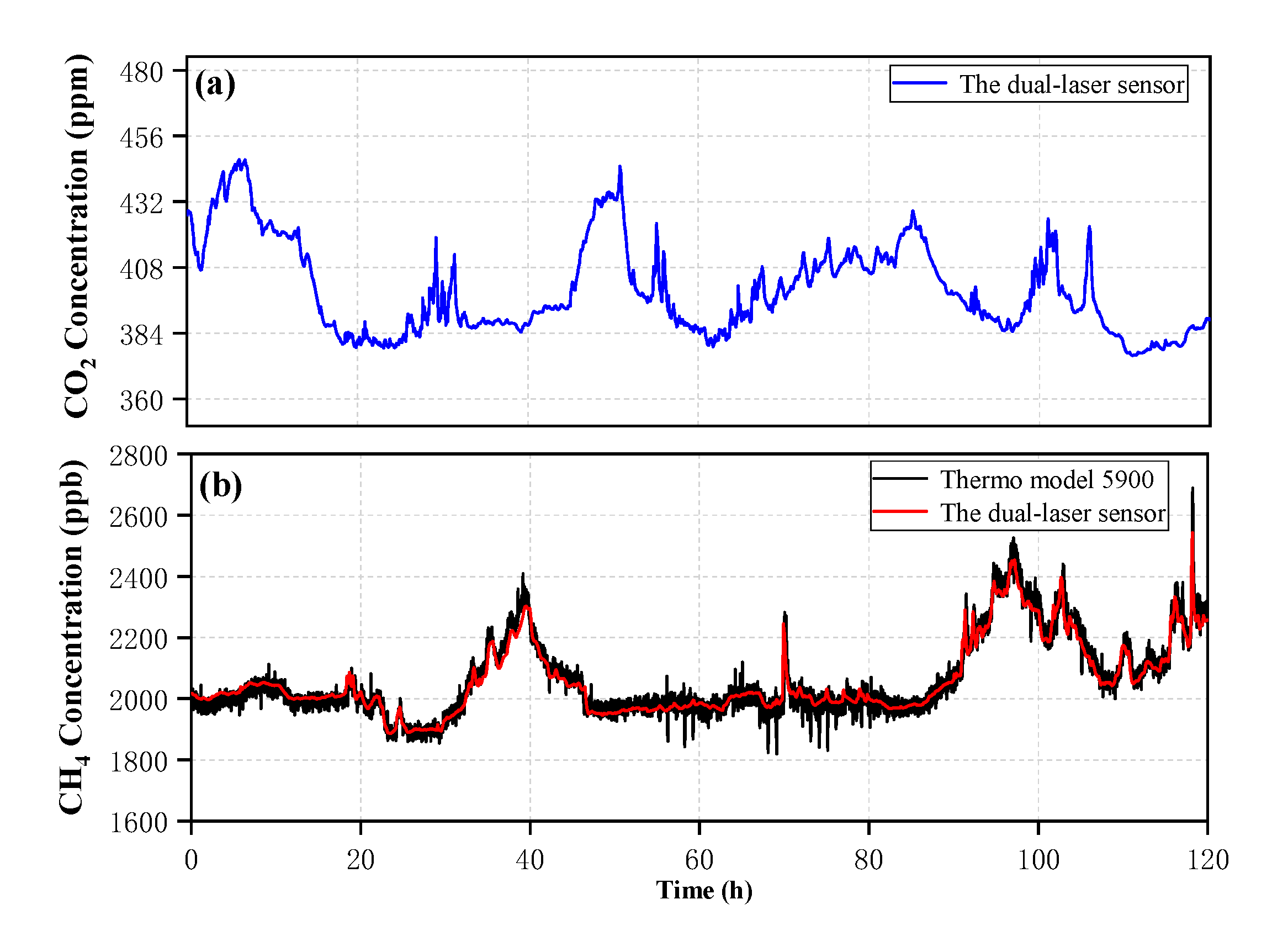
| Raw Long-Term 1δ | EMA Long-Term 1δ | |
|---|---|---|
| CO2 | 0.278 ppm | 0.107 ppm |
| CH4 | 1.794 ppb | 0.733 ppb |
Publisher’s Note: MDPI stays neutral with regard to jurisdictional claims in published maps and institutional affiliations. |
© 2020 by the authors. Licensee MDPI, Basel, Switzerland. This article is an open access article distributed under the terms and conditions of the Creative Commons Attribution (CC BY) license (http://creativecommons.org/licenses/by/4.0/).
Share and Cite
Wang, K.; Shao, L.; Chen, J.; Wang, G.; Liu, K.; Tan, T.; Mei, J.; Chen, W.; Gao, X. A Dual-Laser Sensor Based on Off-Axis Integrated Cavity Output Spectroscopy and Time-Division Multiplexing Method. Sensors 2020, 20, 6192. https://doi.org/10.3390/s20216192
Wang K, Shao L, Chen J, Wang G, Liu K, Tan T, Mei J, Chen W, Gao X. A Dual-Laser Sensor Based on Off-Axis Integrated Cavity Output Spectroscopy and Time-Division Multiplexing Method. Sensors. 2020; 20(21):6192. https://doi.org/10.3390/s20216192
Chicago/Turabian StyleWang, Kunyang, Ligang Shao, Jiajin Chen, Guishi Wang, Kun Liu, Tu Tan, Jiaoxu Mei, Weidong Chen, and Xiaoming Gao. 2020. "A Dual-Laser Sensor Based on Off-Axis Integrated Cavity Output Spectroscopy and Time-Division Multiplexing Method" Sensors 20, no. 21: 6192. https://doi.org/10.3390/s20216192
APA StyleWang, K., Shao, L., Chen, J., Wang, G., Liu, K., Tan, T., Mei, J., Chen, W., & Gao, X. (2020). A Dual-Laser Sensor Based on Off-Axis Integrated Cavity Output Spectroscopy and Time-Division Multiplexing Method. Sensors, 20(21), 6192. https://doi.org/10.3390/s20216192






